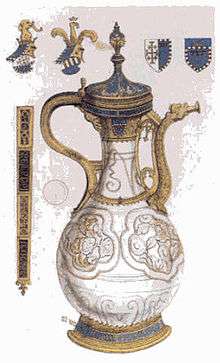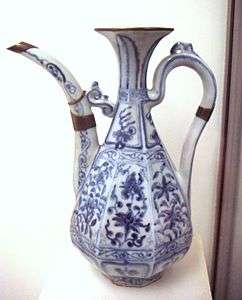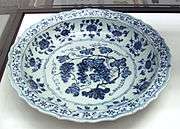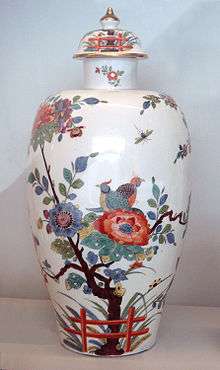Jingdezhen ware

Jingdezhen ware (Chinese: 景德镇陶瓷) refers to ceramics, particularly porcelain, produced in the vicinity of Jingdezhen, China. Jingdezhen is believed to have produced pottery as early as the sixth century CE.
Jingdezhen bluish-white ware

Jingdezhen ware became particularly important from the Song period with the production of Qingbai (青白, "Blueish-white") ware. The Jingdezhen Qingbai was a transparent and jade-like type of porcelain, with a blueish-white glaze. Decoration was made by delicate carving or incising.[1]
The earliest piece of Chinese porcelain documented to have reached Europe, was a Qingbai porcelain bottle from Jingdezhen, which arrived in Europe in the middle of the 14th century: the Fonthill vase.

Later, Jingdezhen produced Shufu ware, named after the two character inscription on some pieces. Shufu may mean the pieces were ordered for the Shumiyuan (Ministry of Defense). The Shufu pieces have a thick, somewhat opaque, glaze, almost white in color, with a faint blue-green tint.[1]
-

Qingbai glazed lamp, Jingdezhen ware, 1271-1368.
-

Shufu stem bowl, Jingdezhen, 1271-1368.
Jingdezhen blue-and-white porcelain

From the mid-14th century, Jindezhen began to mass-produced underglaze blue porcelain.[1] During the Ming period, official kilns for Imperial productions were established in Jingdezhen.[1]
-

Yuan dynasty dish with a white dragon and pearl design on a monochrome blue background, British Museum
-

Dish with underglaze blue design of interlaced flowers, Jingdezhen ware, Xuande Reign 1426-1435, Ming, Shanghai Museum
-

Dish with underglazed blue design of 2 lions playing a ball, Jingdezhen ware, mid 15th century, Shanghai Museum
-

Foliated dish with underglaze blue design of melons, bamboo and grapes, Jingdezhen ware, Yuan, 1271-1368, Shanghai Museum
-

Beaker-Shaped Vase with Four Animals. The Walters Art Museum.
-

Jingdezhen ware dish with underglaze blue dragon on yellow enamel, Ming, British Museum
Qing period
With the Qing period, designs became more varied, combined folk and Imperial styles, and Jingdezhen ware became famous around the world.[1] Export were hampered after the French jesuit François Xavier d'Entrecolles visited Jingdezhen and wrote to Europe about its manufacturing secret between 1712 and 1720. From that point, European countries would start to rival Chinese porcelain productions, initially by imitating Chinese styles, and later by developing their own original artistic patterns.
-

Cowpea-red glazed seal-box, Jingdezhen ware, Kangxi reign 1662-1722, Shanghai Museum
-

Dish with underglazed blue and overglazed red design of clouds and dragons, Jingdezhen ware, Yongzheng reign 1723-1735, Qing, Shanghai Museum
Contemporary productions


Jingdezhen ware continues to be produced, with Jingdezhen porcelain being shipped around the world.
See also
Notes
References
- Dillon, Michael (1992). "Transport and marketing in the development of the Jingdezhen porcelain industry during the Ming and Qing dynasties". Journal of the Economic and Social History of the Orient 35 (3): 278–290. JSTOR 3632734.
- Hanaoka and Barberri trans., Masahiko Sato, Chinese Ceramics: A Short History, Weatherhill, New York and Tokyo, 1981, 195-205.
External links
- A Handbook of Chinese Ceramics from The Metropolitan Museum of Art
- The Pottery Workshop Residencies, Groups, Classes and Gallery in Jingdezhen, China.
- Melanie Sherman Work of ceramic artist resident at Jingdezhen.
| Wikimedia Commons has media related to Jingdezhen ware. |

